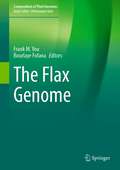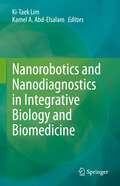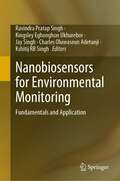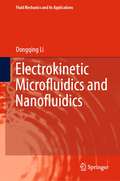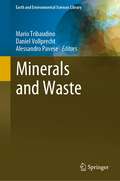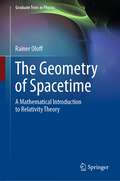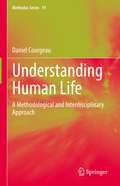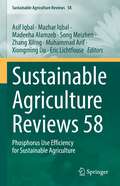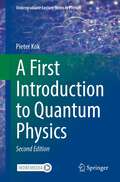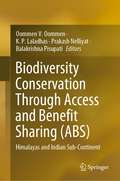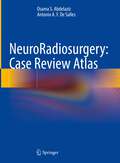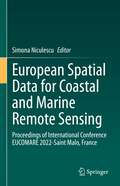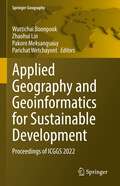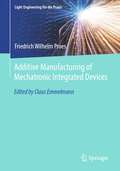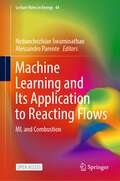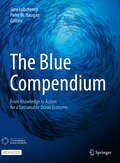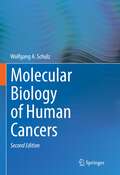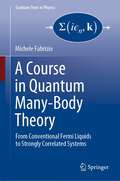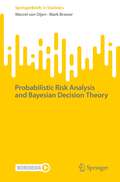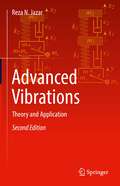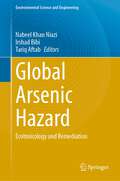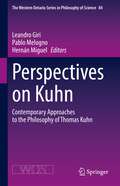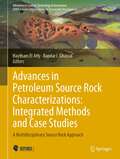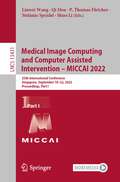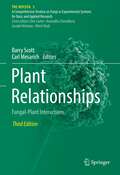- Table View
- List View
The Flax Genome (Compendium of Plant Genomes)
by Frank M. You Bourlaye FofanaThe Flax Genome is a comprehensive compilation of most recent studies focused on reference genome, genetic resources and molecular diversity, breeding, QTL mapping, gene editing tools, functional genomics and metabolomics, molecular breeding via genomic selection, and genomic resources. The flax genome reference sequences and the new genome assemblies are presented. A list of flax QTL and candidate genes associated with more than 35 traits, including yield and agronomic, seed quality and fatty acid composition, fibre quality and yield, abiotic stress, and disease resistance traits, are summarized. A QTL- based genomic selection strategy and genome–editing tools are systematically introduced. In addition, huge amounts of flax genomic resources generated in the last decade are summarized. The book contains 13 chapters with about 390 pages authored by globally reputed researchers in the relevant fields to this crop The book is intended to be useful to students, teachers, andresearchers interested in traditional and molecular breeding, pathology, molecular genetics and breeding, bioinformatics and computational biology, and functional genomics
Nanorobotics and Nanodiagnostics in Integrative Biology and Biomedicine
by Ki-Taek Lim Kamel A. Abd-ElsalamNanorobotics and Nanodiagnostics in Integrative Biology and Biomedicine "Nanorobotics and nanodiagnostics” can be defined as a new generation of biohybrid and nanorobotics that translate fundamental biological principles into engineering design rules, or integrative living components into synthetic structures to create biorobots and nanodiagnotics that perform like natural systems. Nanorobots or nanobots are structured of a nanoscale made of individual assemblies. They can be termed as intelligent systems manufactured with self-assembly strategies by chemical, physical and biological approaches. The nanorobot can determine the structure and enhance the adaptability to the environment in interdisciplinary tasks."Nanorobotics and nanodiagnostics" is a new generation of biohybrid that translates fundamental biological principles into engineering design rules to create biorobots that perform like natural systems. These biorobotics and diagnostics can now perform various missions to be accomplished certain tasks in the research areas such as integrative biology and biomedicine. "Nanorobotics and Nanodiagnostics in Integrative Biology and Biomedicine" sheds light on a comprehensive overview of the multidisciplinary areas that explore nanotherapeutics and nanorobotic manipulation in biology and medicine. It provides up-to-date knowledge of the promising fields of integrative biology and biomedicine for nano-assisted biorobotics and diagnostics to detect and treat diseases that will enable new scientific discoveries.
Nanobiosensors for Environmental Monitoring: Fundamentals and Application
by Ravindra Pratap Singh Kingsley Eghonghon Ukhurebor Jay Singh Charles Oluwaseun Adetunji Kshitij Rb SinghThis book entails detailed information on the utilization of nanobiosensor as an effective technology for the effective detection, monitoring, and management of environmental contaminations to ensure its sustainability and humanity's well-being. The higher level of anthropogenic action has been identified as a threat to humankind's existence due to the higher level of xenobiotic and toxic substances that could interrupt the normal ecosystem. This has prompted numerous agencies both locally and internationally that could play a significant role in environmental pollution mitigation. The application of nanobiosensor has been identified as a sustainable technique that could be applied to ensure proper detection and identification of several environmental contaminants. Nanomaterial’s possible applications created an innovative domain called nanomaterials based biosensors machinery as one of nanotechnology's ultimate sub-divisions. The application of nanomaterials based biosensors machinery and their advancements could be applied globally to resolve numerous environmental sectors' challenges to guarantee the environment's quality and safety. The book will be an excellent collection of reviews based on contemporary research and developments on nanomaterials utilization and applications in environmental monitoring along with their prospects. The book will attempt to give a comprehensive idea of nanomaterial concepts for nanobiosensors applications in an environmental context to help students, researchers, and professionals/practitioners recognize nanomaterials' significance in the environmental domain. The book will also help understand and address the environmental sectors' complications via nanomaterials' utilization and applications. Hence, this book will serve as a textbook and will help students, professionals/practitioners, scientists, researchers, and academicians in various research domains.
Electrokinetic Microfluidics and Nanofluidics (Fluid Mechanics and Its Applications #133)
by Dongqing LiThis book reviews the latest advancement of microfluidics and nanofluidics with a focus on electrokinetic phenomena in microfluidics and nanofluidics. It provides fundamental understanding of several new interfacial electrokinetic phenomena in microfluidics and nanofluidics. Chapter 1 gives a brief review of the fundamentals of interfacial electrokinetics. Chapter 2 shows induced charge electrokinetic transport phenomena. Chapter 3 presents the new advancement in DC dielectrophoresis. Chapter 4 introduces a novel nanofabrication method and the systematic studies of electrokinetic nanofluidics. Chapter 5 presents electrokinetic phenomena associated with Janus particles and Janus droplets. Chapter 6 introduces a new direction of electrokinetic nanofluidics: nanofluidic iontronics. Chapter 7 discusses an important differential resistive pulse sensor in microfluidics and nanofluidics.
Minerals and Waste (Earth and Environmental Sciences Library)
by Mario Tribaudino Daniel Vollprecht Alessandro PaveseIn the field of waste disposal, recovery, and recycling, industrial residues from ceramic and mining activities are just an assemblage of minerals. So is municipal waste, after removing the organic part in incinerators or after long-time disposal. In almost every case, a natural counterpart is present. Applying what is known from natural systems on waste assemblages is the key to predicting their fate, at a short and long time, and suggesting the best for high-temperature recycling.This book aims to bring the Earth Science community to the edge of waste management, offering background information, the basics of high and low-temperature geochemistry involved, and an overview of waste investigation connected to minerals. This book also addresses mineral tailings, incinerator bottom, fly ashes, metal slags, ceramic industry residue, and eventually sanitary issues.The primary readership will be graduate students and professionals in geological and environmental fields.
The Geometry of Spacetime: A Mathematical Introduction to Relativity Theory (Graduate Texts in Physics)
by Rainer OloffThis book systematically develops the mathematical foundations of the theory of relativity and links them to physical relations. For this purpose, differential geometry on manifolds is introduced first, including differentiation and integration, and special relativity is presented as tensor calculus on tangential spaces. Using Einstein's field equations relating curvature to matter, the relativistic effects in the solar system including black holes are discussed in detail. The text is aimed at students of physics and mathematics and assumes only basic knowledge of classical differential and integral calculus and linear algebra.
Understanding Human Life: A Methodological and Interdisciplinary Approach (Methodos Series #19)
by Daniel CourgeauThis book addresses the challenge of understanding human life. It compares our life experience with the attempts to grasp it by astrologers, eugenicists, psychologists, neuroscientists, social scientists, and philosophers. The main opposition among these specialties lies between understanding and misunderstanding. The book also addresses the central methodological difficulty of capturing a human life. It is first examined how certain approaches may lead to a misunderstanding of human life. The book contrasts the example of astrology—an accepted practice in ancient civilizations, but now classified among the pseudosciences—with astronomy, a full-fledged science since Galileo’s time. Another, more recent approach regards human life as predetermined by genes: the methods used by eugenicists, and later by political regimes under the name of hereditarianism, came to compete with genetics. A broader analysis shows how astrology and eugenicism are not truly scientific approaches. Next, the book looks at the ways of capturing an imaginary or real human life story. A comprehensive approach will try to fully understand their complexity, while a more explanatory approach considers only certain specific phenomena of human life. For example, demography studies only births, deaths, and migration. Another crucial factor in the collection of life histories is memory and its transmission. Psychology and psychoanalysis have developed different schools to try to explain them. The book concludes with a detailed discussion of the concepts and tools that have been proposed in more recent times for understanding the various aspects of life stories: mechanisms, systems, hermeneutics, and autonomy.
Sustainable Agriculture Reviews 58: Phosphorus Use Efficiency for Sustainable Agriculture (Sustainable Agriculture Reviews #58)
by Asif Iqbal Mazhar Iqbal Madeeha Alamzeb Song Meizhen Zhang Xiling Muhammad Arif Xiongming Du Eric LichtfouseThis book presents recently-developed crop, soil, and management practices that can be used to improve phosphorous use efficiency in agriculture. Food security highly depends on the availability of plant nutrients such as phosphorus, yet rock phosphate reserves are expected to be exhausted in the next 50–100 years. Moreover, about 80% of the phosphorous fertilizers applied to soils become unavailable to plants due to phosphorous fixation in iron and aluminum oxides in acidic soils and with carbonates in alkaline soils. As a consequence, only 10-15% of applied phosphorous is up taken by crops. Therefore, there is a need for advanced practices for improving phosphorus use efficiency.
A First Introduction to Quantum Physics (Undergraduate Lecture Notes in Physics)
by Pieter KokIn this undergraduate textbook, now in its 2nd edition, the author develops the quantum theory from first principles based on very simple experiments: a photon traveling through beam splitters to detectors, an electron moving through magnetic fields, and an atom emitting radiation. From the physical description of these experiments follows a natural mathematical description in terms of matrices and complex numbers.The first part of the book examines how experimental facts force us to let go of some deeply held preconceptions and develops this idea into a description of states, probabilities, observables, and time evolution. The quantum mechanical principles are illustrated using applications such as gravitational wave detection, magnetic resonance imaging, atomic clocks, scanning tunneling microscopy, and many more. The first part concludes with an overview of the complete quantum theory.The second part of the book covers more advanced topics, including the concept of entanglement, the process of decoherence or how quantum systems become classical, quantum computing and quantum communication, and quantum particles moving in space. Here, the book makes contact with more traditional approaches to quantum physics. The remaining chapters delve deeply into the idea of uncertainty relations and explore what the quantum theory says about the nature of reality.The book is an ideal accessible introduction to quantum physics, tested in the classroom, with modern examples and plenty of end-of-chapter exercises.
Biodiversity Conservation Through Access and Benefit Sharing (ABS): Himalayas and Indian Sub-Continent
by K. P. Laladhas Oommen V. Oommen Prakash Nelliyat Balakrishna PisupatiThis book deals with the economic potentials of biodiversity and its capacity to support its own conservation aiming to provide livelihood for millions engaged in conservation, both now and for future generations. The book highlights the potentials of natural resources which are characterized as capital wealth (as defined in Convention on Biological Diversity (CBD)), to finance its own conservation and to provide livelihood means to people who conserve it.The book is divided into five Parts. PART I explains about the Premise of Access and Benefit Sharing (ABS), PART II describes about the Technology Transfer, PART III will provide details about the Access to Genetic Resources and to Associated Traditional Knowledge and Benefit Sharing PART IV is the Implementation of ABS Mechanisms and PART V is about ABS and Its Economics.This book will be of interest to biodiversity policy makers, administrators, university and college students, researchers, biodiversity conservationists.
NeuroRadiosurgery: Case Review Atlas
by Osama S. Abdelaziz Antonio A.F. De SallesThis book is one-of-a-kind comprehensive Radiosurgery Case Review Atlas that includes not only cranial and spinal cases, but also structural and functional radiosurgery ones. It categorizes the various radiosurgery-treated pathologies, presenting illustrative case reviews for each category. Each case includes a clinical summary, a treatment protocol, a radiosurgery dosimetry summary, the pre-radiosurgery images and the serial, short-term and long-term, follow up images illustrating the clinical and radiologic outcomes of the radiosurgery treatment. Offering the readers a handy step-by-step practical guide to perform safe and effective radiosurgery treatment, this will be a useful toolkit for neurosurgeons, radiation neuro-oncologists and radiation physicists (Radiosurgeons) conducting radiosurgery programs or involved in radiosurgery training.
European Spatial Data for Coastal and Marine Remote Sensing: Proceedings of International Conference EUCOMARE 2022-Saint Malo, France
by Simona NiculescuThis volume presents full paper contributions from the International Conference of European Spatial Data for Coastal and Marine Remote Sensing (EUCOMARE) 2022, with the support of the ERASMUS+ Programme of the European Union, held in Saint Malo, France. EUCOMARE aims to promote academic and technical exchange on coastal related studies including coastal environmental and socio-economic issues, with the use of European remotely sensed data. The book is an excellent resource for scientists, engineers, and programme managers eager to learn about the recent developments and achievements in the field of remote sensing applications on marine and coastal areas. Readers will learn about recent advances in sensors' radiometric, spatial, temporal and spectral resolution, as well as new data processing approaches in remote sensing for monitoring and mapping the various characteristics of marine, coastal and aquatic systems.
Applied Geography and Geoinformatics for Sustainable Development: Proceedings of ICGGS 2022 (Springer Geography)
by Wuttichai Boonpook Zhaohui Lin Pakorn Meksangsouy Parichat WetchayontThis volume presents the proceedings of the 2nd International Conference of Geography and Geoinformatics for Sustainable Development (ICGGS), held in Phuket, Thailand, April 7-8, 2022. The collection focuses on the importance of spatial thinking and planning by applying geography concepts and geospatial technology innovations in solving global problems such as environmental degradation, urban pollution, and climate change. The proceedings consist of case studies on wide-ranging spatial issues in developing countries, addressing challenges in mainstreaming sustainable development paradigms into their economies to improve natural resource and environmental management. One of the main goals of the volume is to share and exchange different points of view regarding global, regional, and local spatial issues and how to use geography and geoinformatics for building resilience in multiple sectors, e.g., water, ecosystems, agriculture, and health. It offers the opportunity to learn about how geospatial concepts and technologies can contribute to environmental sustainability, while advancing education and research related to geography and geoinformatics. It will be a useful resource for students and researchers to initiate research ideas related to geospatial topics in regional and local scales.
Additive Manufacturing of Mechatronic Integrated Devices (Light Engineering für die Praxis)
by Friedrich Wilhelm ProesIn this dissertation a new process chain for the Additive Manufacturing of Mechatronic Integrated Devices (AMMID) is described, which provides a new way to manufacture 3-dimensional electronic devices based on the selective laser sintering (SLS) process using laser direct structuring (LDS) and metallization. The AMMID process chain meets the rising demand for highly functionalized parts, increasing individualization and shortening development cycles for electronic products.The development for this process chain is based on an extensive literature review that indicates that an SLS-based process chain has great potential to produce 3-dimensional electronic devices with properties and with the future perspective of being suitable for an individualized mass production. The biggest, initial, technical hurdle is an unstable SLS process using a conventional LDS additive. The compound of SLS material and LDS additive was analyzed with DSC, which shows that the additive changes the melting behavior of the polymer by reducing the sintering window. A fine metal powder as an alternative additive affects the sintering window less and enables a stable process. To choose a suitable particle size and content for the metal powder an analytical material model is provided, that predicts the additive particle distribution within the material. This material model deepens the understanding of the activation mechanism during laser activation, provides hands-on information for powder preparation and it is applied for the design of the experiment for the development of the process chain with the new material.Preliminary experiments are conducted along with the insights of the material model, which prove that redeposition is the main activation mechanism during laser activation with fine metal powders. Based on this, the process chain is developed, starting with a determination of a suitable additive content. A suitable material composition of a PA12 powder containing 2 wt.% of a copper powder with a mean particle diameter of 3.5 μm was identified. With regard to the laser activation, working laser parameters are developed (working parameter set feasible for all used post-process treatments: PRF = 1 kHz, dh = 25 μm, vs = 25 mm/s, tl = 20ns and P = 1.07 W). In this parameter development it is shown, that only closely located laser spots, enabling interaction of the laser pulses, are capable of activating the surface, while single laser pulses under applied conditions are not. By adding a post-process treatment as additional process step into the process chain, the quality of metallization and the size of design features could be improved. Chemical smoothing resulted in a complete reduction of unwanted metallization on non-activated surfaces. Conductor tracks with the minimal width of 300 μm could be realized. The process chain could be applied to demonstrator parts such as a drone housing and a PSU panel of an aircraft. Thus, this dissertation has raised the technology readiness level (TRL) from TRL2 to TRL6.Finally, an economic consideration provides insights on the cost structure of parts produced with the AMMID process. A comparison of AMMID and injection molding shows economic viability for small lot sizes, 400 parts in case of the drone housing and 150 parts in case of the PSU panel. Finally, the analysis of the cost structure gives advice which future developments in the process chain have the greatest effect on costs and provides prioritization.
Machine Learning and Its Application to Reacting Flows: ML and Combustion (Lecture Notes in Energy #44)
by Nedunchezhian Swaminathan Alessandro ParenteThis open access book introduces and explains machine learning (ML) algorithms and techniques developed for statistical inferences on a complex process or system and their applications to simulations of chemically reacting turbulent flows.These two fields, ML and turbulent combustion, have large body of work and knowledge on their own, and this book brings them together and explain the complexities and challenges involved in applying ML techniques to simulate and study reacting flows. This is important as to the world’s total primary energy supply (TPES), since more than 90% of this supply is through combustion technologies and the non-negligible effects of combustion on environment. Although alternative technologies based on renewable energies are coming up, their shares for the TPES is are less than 5% currently and one needs a complete paradigm shift to replace combustion sources. Whether this is practical or not is entirely a different question, and an answer to this question depends on the respondent. However, a pragmatic analysis suggests that the combustion share to TPES is likely to be more than 70% even by 2070. Hence, it will be prudent to take advantage of ML techniques to improve combustion sciences and technologies so that efficient and “greener” combustion systems that are friendlier to the environment can be designed. The book covers the current state of the art in these two topics and outlines the challenges involved, merits and drawbacks of using ML for turbulent combustion simulations including avenues which can be explored to overcome the challenges. The required mathematical equations and backgrounds are discussed with ample references for readers to find further detail if they wish. This book is unique since there is not any book with similar coverage of topics, ranging from big data analysis and machine learning algorithm to their applications for combustion science and system design for energy generation.
The Blue Compendium: From Knowledge to Action for a Sustainable Ocean Economy
Home to over 80 percent of all life on Earth, the ocean is the world’s largest carbon sink and a key source of food and economic security for billions of people. The relevance of the ocean for humanity's future is undisputed. However, the ocean’s great potential to drive economic growth and equitable job creation, sustain healthy ecosystems, and mitigate climate change is not yet fully recognised. Lack of awareness of this potential as well as management and governance challenges pose impediments. Until these impediments are removed, ocean ecosystems will continue to be degraded and opportunities for people lost. A transition and a clear path to a thriving and vibrant relationship between humans and the ocean are urgently needed. This open access collection of papers and reports identifies a path that is inspired by science, energised by engaged people, and emboldened by visionary leaders. These assessments of knowledge are commissioned by the High Level Panel for a Sustainable Ocean Economy (Ocean Panel), which was established in September 2018 as a unique initiative led by heads of state and government from around the world, to showcase the latest leading-edge science, knowledge and state-of-the-art thinking on key ocean issues. Altogether, The Blue Compendium offers innovative ocean solutions in technology, policy, governance, and finance realms, that could help accelerate a transition to a more sustainable and prosperous relationship with the ocean. The comprehensive assessments have already informed policy making at the highest levels of government and motivated an impressive array of responsive and ambitious action across a growing network of leaders in business, finance and civil society.
Molecular Biology of Human Cancers
by Wolfgang A. SchulzCancer research is now an interdisciplinary effort requiring a basic knowledge of commonly used terms, facts, issues, and concepts. This interdisciplinary book meets this need, providing an authoritative overview to the field. It presents many of the molecules and mechanisms generally important in human cancers and examines a broad, but exemplary, selection of cancers. In addition, cancer research has now reached a critical stage, in which the accumulated knowledge on molecular mechanisms is gradually translated into improved prevention, diagnosis, and treatment. This book summarizes the state, pitfalls, and potential of these efforts.
A Course in Quantum Many-Body Theory: From Conventional Fermi Liquids to Strongly Correlated Systems (Graduate Texts in Physics)
by Michele FabrizioThis textbook presents various methods to deal with quantum many-body systems, mainly addressing interacting electrons. It focusses on basic tools to tackle quantum effects in macroscopic systems of interacting particles, and on fundamental concepts to interpret the behavior of such systems as revealed by experiments.The textbook starts from simple concepts like second quantization, which allows one to include the indistinguishability and statistics of particles in a rather simple framework, and linear response theory. Then, it gradually moves towards more technical and advanced subjects, including recent developments in the field. The diagrammatic technique is comprehensively discussed. Some of the advanced topics include Landau’s Fermi liquid theory, Luttinger liquids, the Kondo effect, and the Mott transition.The ultimate goal of the book is to gain comprehension of physical quantities that are routinely measured experimentally and fully characterize the system, therefore it is useful for graduate students but also young researchers studying and investigating the theoretical aspects of condensed matter physics.
Probabilistic Risk Analysis and Bayesian Decision Theory (SpringerBriefs in Statistics)
by Mark Brewer Marcel van OijenThe book shows how risk, defined as the statistical expectation of loss, can be formally decomposed as the product of two terms: hazard probability and system vulnerability. This requires a specific definition of vulnerability that replaces the many fuzzy definitions abounding in the literature. The approach is expanded to more complex risk analysis with three components rather than two, and with various definitions of hazard. Equations are derived to quantify the uncertainty of each risk component and show how the approach relates to Bayesian decision theory. Intended for statisticians, environmental scientists and risk analysts interested in the theory and application of risk analysis, this book provides precise definitions, new theory, and many examples with full computer code. The approach is based on straightforward use of probability theory which brings rigour and clarity. Only a moderate knowledge and understanding of probability theory is expected from the reader.
Advanced Vibrations: Theory and Application
by Reza N. JazarNow in an updated new edition, this textbook explains mechanical vibrations concepts in detail, concentrating on their practical use. This second edition includes the new chapter Multi-Degree-of-Freedom (MDOF) Time Response, as well as new sections covering superposition, music and vibrations, generalized coordinates and degrees-of-freedom, and first-order systems. Related theorems and formal proofs are provided, as are real-life applications. Students, researchers, and practicing engineers alike will appreciate the user-friendly presentation of a wealth of topics, including practical optimization for designing vibration isolators and transient and harmonic excitations. Advanced Vibrations: Theory and Application is an ideal text for students of engineering, designers, and practicing engineers.
Global Arsenic Hazard: Ecotoxicology and Remediation (Environmental Science and Engineering)
by Tariq Aftab Nabeel Khan Niazi Irshad BibiThis book provides a plethora of information about global arsenic (As) contamination and the challenges for environment. Arsenic is a naturally occurring metalloid that is widely distributed in water, soil, air and biota from natural and anthropogenic sources. Arsenic has been found in drinking water in over 100 countries worldwide, which caused a major public health issue including: cardiovascular disorders, diabetes, and cancers of various organs - these are some of the general health effects of As exposure. Exposure of plants to As, even at very low concentrations, can cause many morphological, physiological, and biochemical changes. The recent research on As in the water-soil-plant-human systems indicates that As toxicity to plants varies with As speciation in plants, type of plant species and with other soil factors controlling As accumulation in plants. In recent years, the development of efficient green chemistry methods for detoxification of trace metal poisoning has become a major focus of researchers. It has been investigated in order to find an eco-friendly and recyclable technique for the removal of As contamination from the natural resources.Understanding the significance of As hazard and roles of sustainable or eco-friendly approaches in its mitigation, we intend to bring forth a comprehensive volume “Global Arsenic Hazard - Ecotoxicology and Remediation" highlighting the various prospects involved in current scenario. We are hopeful that this comprehensive volume will furnish the requisite of all those who are working or have interest in the proposed topic.
Perspectives on Kuhn: Contemporary Approaches to the Philosophy of Thomas Kuhn (The Western Ontario Series in Philosophy of Science #84)
by Leandro Giri Pablo Melogno Hernán MiguelThis book presents essays and commentaries that continue on Thomas Kuhn’s work from where he left off at the time of his death. Contrary to other books, this volume picks up the gauntlet to develop, from a contemporary perspective, some points that can be improved in the light of recent findings and conceptualizations in metatheory. Thus, this work pays a visit to the classical Kuhnian landscapes, but rather proposing interpretations, it takes them as the starting point to go further. One hundred years after Kuhn's birth, the editors and authors rekindle the passion and interest that have always surrounded the work of the great Boston philosopher and historian.
Advances in Petroleum Source Rock Characterizations: A Multidisciplinary Source Rock Approach (Advances in Science, Technology & Innovation)
by Haytham El Atfy Bandar I. GhassalThis book is directed to those who are interested in petroleum geology, especially source rock from both academia and industrial societies. Our chapter-based book is written by a list of world-class subject-matter experts.The book includes recent advancements in analytical source rock characterization methods with some case studies. It is also used as part of a course curriculum or guide for source rock interpretation for all researcher categories.Significant improvement in the source rock characterization techniques in the last two decades and the knowledge is disseminated in a huge amount of papers and studies. The book intends to collect these recent advancements in one textbook to benefit students and researchers in general. In addition, it is supplemented by many case studies from all over the world that represent important data sets for the regional geology of these areas.
Medical Image Computing and Computer Assisted Intervention – MICCAI 2022: 25th International Conference, Singapore, September 18–22, 2022, Proceedings, Part I (Lecture Notes in Computer Science #13431)
by Linwei Wang Qi Dou P. Thomas Fletcher Stefanie Speidel Shuo LiThe eight-volume set LNCS 13431, 13432, 13433, 13434, 13435, 13436, 13437, and 13438 constitutes the refereed proceedings of the 25th International Conference on Medical Image Computing and Computer-Assisted Intervention, MICCAI 2022, which was held in Singapore in September 2022. The 574 revised full papers presented were carefully reviewed and selected from 1831 submissions in a double-blind review process. The papers are organized in the following topical sections: Part I: Brain development and atlases; DWI and tractography; functional brain networks; neuroimaging; heart and lung imaging; dermatology; Part II: Computational (integrative) pathology; computational anatomy and physiology; ophthalmology; fetal imaging; Part III: Breast imaging; colonoscopy; computer aided diagnosis; Part IV: Microscopic image analysis; positron emission tomography; ultrasound imaging; video data analysis; image segmentation I; Part V: Image segmentation II; integration of imaging with non-imaging biomarkers; Part VI: Image registration; image reconstruction; Part VII: Image-Guided interventions and surgery; outcome and disease prediction; surgical data science; surgical planning and simulation; machine learning – domain adaptation and generalization; Part VIII: Machine learning – weakly-supervised learning; machine learning – model interpretation; machine learning – uncertainty; machine learning theory and methodologies.
Plant Relationships: Fungal-Plant Interactions (The Mycota #5)
by Barry Scott Carl MesarichThis fully revised 3rd edition provides a comprehensive overview of the biology of fungi associated with plants. Since the publication of the 2nd Edition in 2009, tremendous new knowledge has been gained in the field of fungal-plant interactions, which is reflected in the contributions of this book. World-leading scientists in the field provide authoritative insights into fungal-plant interactions covering the following main topics:Mutualistic and pathogenic fungal-plant interactions in natural and agricultural ecosystemsSensing and signalling in fungus-plant interactionsRegulation of fungal gene expression and developmentFungal genomes and evolutionGlobal pandemics caused by fungal pathogens and their implications for food securityThis volume will be of great interest to both specialists and generalists. It is an indispensable resource for researchers, lecturers and students in microbiology, mycology, and plant sciences, as well as agriculture and biotechnology.
